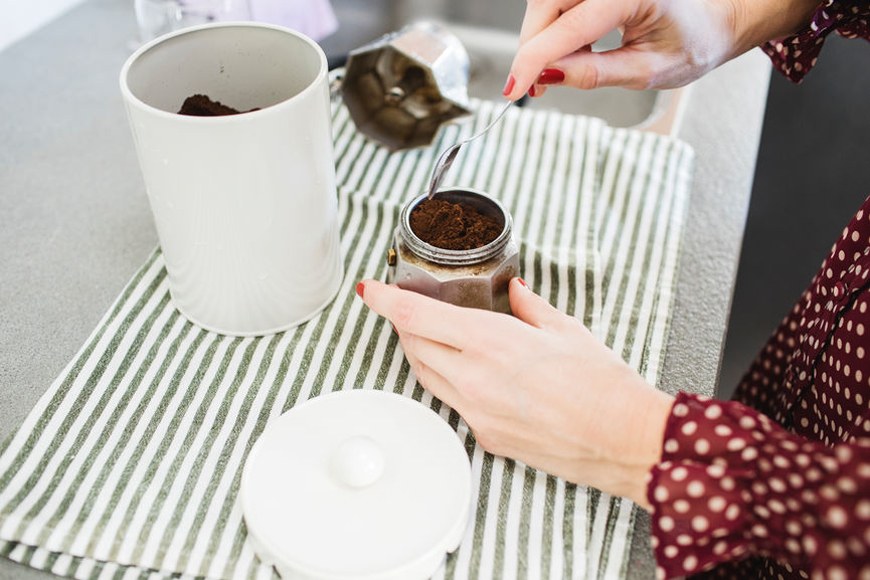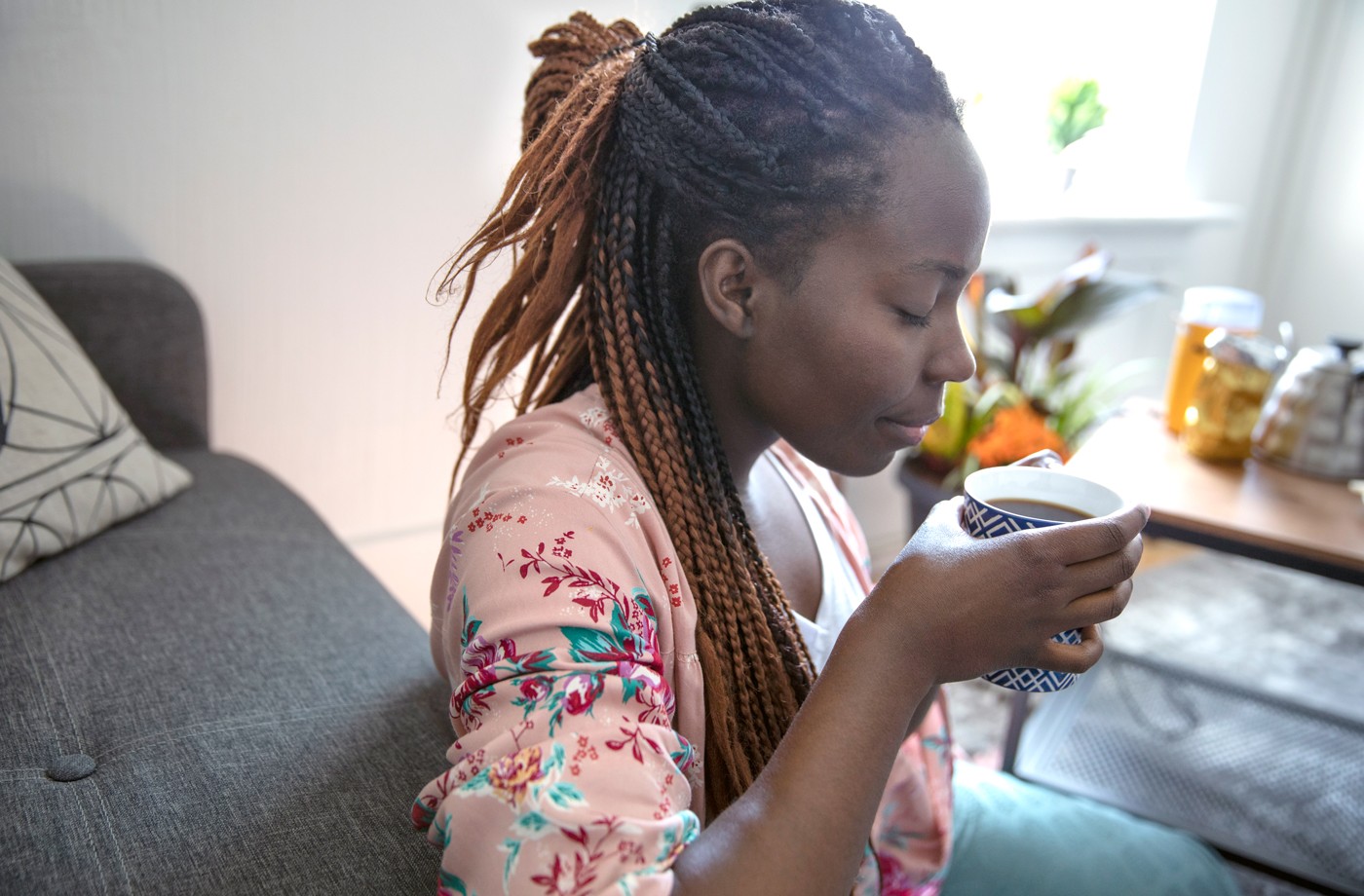The Way You Brew Your Coffee Affects Its Caffeine Levels—Here’s How
When you're looking for a caffeine content that could wake the dead (or, on the flip side, a gentle boost to get you through the afternoon without ruining your sleep), there are a few factors to keep in mind that determine how much caffeine you're actually getting from that cup of joe.
One of the biggies: Your brewing method of choice. Different methods have different levels of extraction, explains Bob Arnot, M.D., an internal medicine doctor and author of The Coffee Lover's Bible.
As he explains it, brewing methods with higher levels of extraction get more caffeine and polyphenols out of your grind, essentially. (Polyphenols are active compounds found in coffee that help with heart, brain, and gut health, among many other benefits.)
Here's what you need to know about how your brewing method affects the caffeine level of your coffee.

What you're brewing matters
Before the brewing process even begins, the beans you choose play a role in how much caffeine you're getting. "Caffeine is an insect repellant, so at very low altitudes, there's more caffeine [in coffee beans] because there are more insects," explains Dr. Arnot. "At very high altitudes, there are far fewer insects, so there's less caffeine." In other words, coffee beans from high altitudes haven't had to adapt to ward off annoying bugs, so they have less caffeine.
High altitude coffees also tend to have more polyphenols thanks to nutrient-dense soils. (Examples of high-altitude coffee-growing regions include Ethiopia, Kenya, Colombia, and Brazil.) From there, the brewing process you choose will determine how much of that caffeine and polyphenol content you're actually getting out of your coffee.
Grind size is the first factor. "The smaller the grind size, the bigger the surface area [of the grind]," says Dr. Arnot. "A grind as fine as a cosmetic powder is the one that gives you the very highest extraction." Of course, it's not as simple as just using a fine grind size all the time—different coffee brewing methods require differing grind sizes.
Water temperature is another factor—Dr. Arnot says that higher temperatures have higher extractions, something he saw over and over again in his extensive coffee brewing testings for his book. (This study backs him up.) Finally, the general brewing style also determines how much caffeine you're getting. In immersion techniques (as opposed to pour-over techniques), the particles are completely enveloped by water, yielding higher extractions. Plus, you can leave them sitting for more time, which also adds to the extraction.

{{post.sponsorText}}
Here's how common brewing methods stack up, from highest caffeine to lowest caffeine.

Within each brewing method, the type of beans you choose will help determine exactly how many milligrams of caffeine you're consuming, as well as variables like your ratio of water to coffee grounds. Using more coffee grounds will net you more caffeine, while using more water dilutes the brew. But in general, here's how common brewing methods rank in extraction potential, from the most to the least:
Turkish coffee and cowboy coffee
Chances are, these aren't your go-to methods at home, but they are the highest extractors. Basically, they combine ultra-fine coffee grinds and boiling water, with no filtering. "[These are] immersive techniques where all the grinds are in the water itself, so you have complete contact on all sides of that grind for two minutes or more," says Dr. Arnot.
Unfortunately, these coffees are pretty bitter thanks to over-extraction. "[They] taste dreadful, which is why people have to put so much sugar and milk in them," Dr. Arnot says. You'll get some grit from the coffee grounds, too.
Pour-over techniques (Including Kalita, Chemex, and Hario)
As for brewing methods you might actually use at home (or find in a craft coffee shop), pour-over techniques have the highest extractions.
With these, you generally have to use a slightly larger grind size than you do with the immersion techniques above. "If you use a very, very fine grind size in a pour-over, it just sops all the water up and nothing goes through, so you have a great big wet mess of coffee [grounds] and, say, three drips [of actual liquid]," Dr. Arnot says.
But, you can still extract quite a bit of caffeine from the medium to fine grind sizes used in these methods, especially because you're slowly pouring very hot water over them. (Remember, finer grind sizes + hotter temperatures = more caffeine.)
AeroPress
This method is comparable to pour-over methods in terms of to caffeine levels, says Dr. Arnot. It's technically an immersion method (like Turkish coffee and cowboy coffee), but you have to use a medium grind size in an AeroPress.
Don't try and cheat the system by using a finer grind size, he warns—thanks to the pressure needed to push the plunger down, a too-fine grind size can actually end up "exploding" out of the device. (For one, that's an annoying mess to clean up, but the hot water can also lead to burns.)
Automatic drip and single-cup coffee makers
"Regular" coffee machines are a tier below immersion and manual pour-over methods when it comes to extraction. For one, they require a coarser grind size. "We also found that in looking at these automatic coffee makers, they were just much lower temperatures," says Arnot. "The lower temperature equals lower extraction."
Single-cup brewing machines (like Keurigs) also fall into this category, but you might be able to get a little more caffeine out of them. "You can put a lot of coffee in those Keurig cups, and some brewers have hotter water," says Arnot. "So in theory, by playing around with these factors, you can get a decent extractions."
French press
While there's something that just feels fancy and elegant about using a French press, you won't get high extractions out of it. Even though it's an immersion method and you use very hot water, "French press ranked the lowest of all the artisanal techniques because it's such a coarse grind size," Dr. Arnot says. (If you used a finer grind size, you'd end up with lots of coffee grounds in your cup.)
Cold brew
The reason this ranks last on the list of brewing methods, extraction-wise, is right there in the name—it's cold. "Cold brew is an under-extraction technique, so you probably extract 75 to 80 percent of what you get in hot brew, and that's because you don't have the hot temperature," Dr. Arnot says. "You increase the time to try to make up for a much lower temperature, and you can't use a super fine grind size."
That said, the caffeine in a cup of cold brew really depends on how concentrated it is. For example, drinking a cup of straight cold brew concentrate would be pretty intense—usually, it's diluted with water or milk.
While this might sound like a ranking of best to worst, lower extraction methods aren't necessarily inferior to higher extraction methods—in fact, it means you can drink more coffee, and reap more of the health benefits.
"If you were to have a cup of coffee that's super high in caffeine, you're depriving yourself of polyphenols, because you can't drink enough of it," says Dr. Arnot. This is also a great reason to choose those high-altitude coffee beans, since they have more polyphenols and less caffeine.
And, hey, if you're a coffee lover, the opportunity to drink more coffee—without ending up with the shakes or a queasy stomach—is definitely a good thing.
Here's how the caffeine in coffee compares to matcha, black tea, and other wellness drinks. And this is the state with the very best brew.
Loading More Posts...